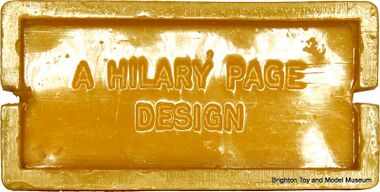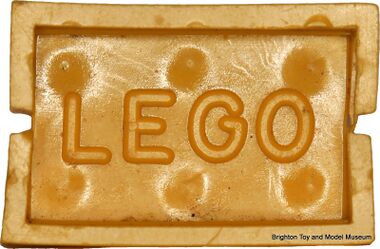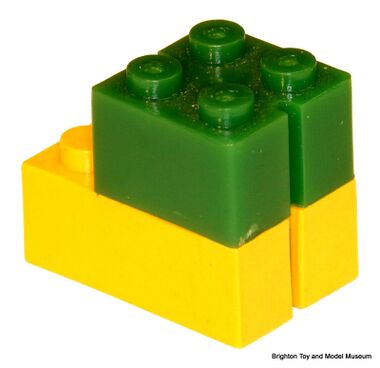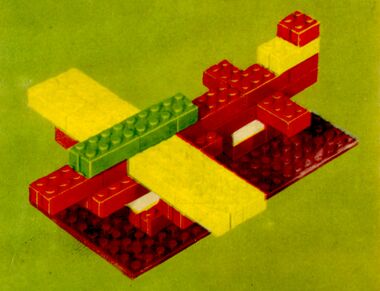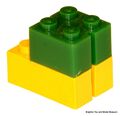Category:Automatic Binding Bricks - Lego Mursten (Lego)
Bricks: Original
|| Transitional
|| Modern
Town Plan
|| Cars
|| Roofs
|| Windows and Doors
|| Wheels
Underside of a (non-Lego) Hilary Page 2×4 Kiddicraft Brick [image info]
Corresponding underside of a 1955- "Lego Mursten" 2×3 brick [image info]
A green "Kiddcraft" brick (top) clipped to a yellow "Lego Mursten" brick (bottom [image info]
~1953: Detail from a "Lego Mursten" set's box artwork, showing bricks with end-slots [image info]
The Lego company's Automatic Binding Bricks were the company's first incarnation of what we now know as Lego bricks.
The bricks were one of the Lego company's first plastic products after acquiring their injection-moulding machine, and were clones of the Kiddicraft Self-Locking Building Bricks designed by Hilary Page over in England.
Design changes from the Kiddicraft bricks
Like the Page bricks, the first Lego bricks had slotted ends with a tapered slot, and their dimensions were pretty much indistinguishable from Page's – they were quite clearly copies.
The changes that the Lego company made were:
- Page had fractionally softened or rounded the four vertical edges of each brick. Due to Page's focus on safely and handling, this was probably to make the eight corners of the brick less sharp (and therefore less painful to stand on!). Lego made the four vertical edges sharp right-angles.
- Page had added a small low-profile "nubbin" in the middle of each stud, presumably to make it easier for small clumsy hands to locate a pair of bricks to fit together. If a small child pushed a pair of bricks together hard and they were a little misaligned, the curve of the nubbin would tend to give the bricks a sideways shove in the right direction. Lego flattened the tops of the studs ... and some years later used the flat tops as a convenient place to put the LEGO logo.
- The undersides of the Page bricks had had a variety or markings, with Hilary Page's name, the Kiddicraft name, and the name of the injection moulding machine company.
Design variations
Early bricks by Lego (1949-) had end-slots and no obvious maker's name.
Later versions (~1955?-) had the Lego name prominently shown on the inside, in simple raised lettering that looked at if it might have been engraved into the mould with a milling machine.
Still later versions had more variation in where the slots were: if a model house was to have a window very near a side-wall, then some of the staggered bricks would need the slot in the side of one end rather than in the end. This resulted in some slightly random-looking (but quite sensible) combinations and variations of slot positions.
Later again (the inverso.com site suggests circa ~1954), the bricks started to appear with the Lego name executed as an outline of the actual Lego logo.
Size
According to the Lego company, they also changed the brick dimensions from Imperial to metric ... but given that Page was very forward-thinking, and there are not obvious official dimensions for the Page bricks in Imperial, it'd difficult to know what caused the Lego company to believe that the original bricks weren't already designed in metric units. Did they perhaps have access to internal documents or specifications from Kiddicraft's injection moulding company? Or did they have the bricks measured up themselves, and their agent used a British micrometer? It's difficult to know.
The main Lego brick dimensions are officially based on multiples of 1.6 mm: Is this explicable by a correspondence to a nice Imperial fraction of an inch? Not really. It's possible that Page designed the brick height so that three bricks equalled the average inside height of a building in 1:76 scale, the scale of the UK's emerging model railways standard in the 1940s (see: Lego scale).
External links
Pages in category ‘Automatic Binding Bricks - Lego Mursten (Lego)’
This category contains only the following page.
Media in category ‘Automatic Binding Bricks - Lego Mursten (Lego)’
The following 5 files are in this category, out of 5 total.
- Kiddicraft brick (green) and Lego Mursten brick (yellow).jpg 1,600 × 1,548; 147 KB
- Lego Mursten aeroplane, end-slots (Lego ~1953).jpg 1,862 × 1,426; 1.36 MB
- Lego Mursten logo (~1953).jpg 2,000 × 751; 452 KB
- Lego Mursten Set (Lego ~1953).jpg 2,000 × 1,435; 521 KB
- Lego Mursten slotted brick, underside, branded (Lego ~1953).jpg 1,600 × 1,047; 265 KB
